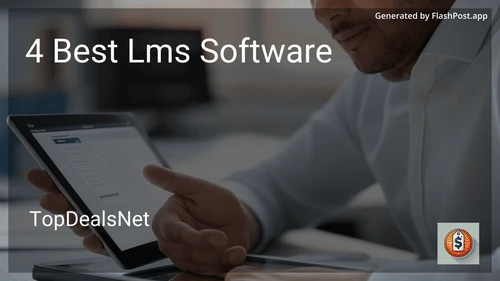Best LMS Software in December 2025

Moodle
- Open-source
- Highly customizable
- Mobile-friendly
- Extensive plugin options

Canvas
- User-friendly interface
- Cloud-native
- Robust analytics
- Comprehensive app integration

Blackboard Learn
- Extensive assessment options
- Customizable learning paths
- Interactive collaboration tools
- Mobile app accessibility

TalentLMS
- Easy course creation
- Automation tools
- Gamification features
- SCORM and xAPI/Tin Can support
In today's fast-evolving digital landscape, Learning Management System (LMS) software plays a pivotal role in enabling organizations and educational institutions to efficiently deliver, manage, and track learning activities. An LMS is an essential tool for creating an engaging and productive learning experience. This article delves into what makes the best LMS software and provides guidance on how to choose the best system to meet your specific needs.
Understanding LMS Software
LMS software is a platform designed to automate and facilitate various aspects of the learning process, including administration, tracking, reporting, and delivery of educational courses or training programs. It is central to implementing online, hybrid, or even traditional classroom learning activities. By converting learning into an interactive online process, LMS tools help educators and trainers deliver content and assess learning in a structured way.
Key Features of an Effective LMS
When evaluating LMS software, it is crucial to consider features that align with your learning objectives and organizational goals. The best LMS software should offer:
1. User-Friendly Interface
A simple and intuitive interface minimizes the learning curve for both instructors and learners. A well-designed LMS should facilitate seamless navigation to maximize learning efficiency.
2. Content Management
The system should support diverse content formats such as videos, PDFs, SCORM-compliant modules, quizzes, and assignments. Additionally, a robust content management feature should allow easy updating and organization of materials.
3. Mobile Compatibility
With the ubiquity of mobile devices, ensuring that the LMS is mobile-responsive is crucial. Learners should be able to access courses on tablets and smartphones without compromising the learning experience.
4. Reporting and Analytics
A powerful analytics dashboard provides insights into learner progress and engagement. Instructors can leverage this data to tailor learning experiences and enhance outcomes.
5. Integration Capabilities
An LMS that integrates with other tools and platforms already used by your organization, such as HR systems or communication tools, can significantly enhance workflow efficiency.
How to Choose the Best LMS Software
Selecting the best LMS software requires careful consideration of several factors to ensure it aligns with your operational and educational strategies. Here are some steps to guide you:
1. Identify Your Needs and Objectives
Clarify your learning objectives and specific needs. Determine whether you need an LMS for corporate training, K-12 education, or higher education. This will influence the features and capabilities you require.
2. Evaluate Scalability and Flexibility
Consider your future growth and ensure the LMS can scale accordingly. Choose a system that offers the flexibility to adapt to evolving learning needs and can accommodate a growing number of users.
3. Assess Technical Support and Customer Service
Reliable customer support is critical for resolving issues quickly. Investigate the vendor's reputation for customer service and the availability of support resources like tutorials and forums.
4. Consider Budget Constraints
Understanding your budgetary constraints is essential. Pricing models can vary significantly from one LMS to another, so opt for a solution that provides value for money without overextending financial resources.
5. Trial and Feedback
Before finalizing your choice, take advantage of free trials or demos to experience the software in action. Involve end-users and gather their feedback to ensure the LMS meets their expectations and enhances the learning process.
Conclusion
Choosing the best LMS software is a strategic decision that can greatly impact the efficiency and effectiveness of learning within an organization. By understanding your specific needs, evaluating key features, and considering scalability and support, you can select an LMS that not only enhances learning outcomes but also provides a sustainable, long-term solution for your educational or training programs.
